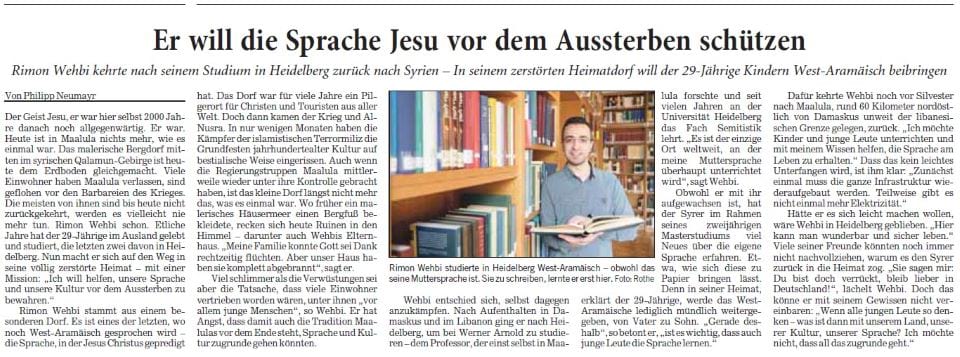Media Reports
1. About Yawna > 1.4. Media Reports
Last modified April 13, 2023
1.4.1. Phil England Message:
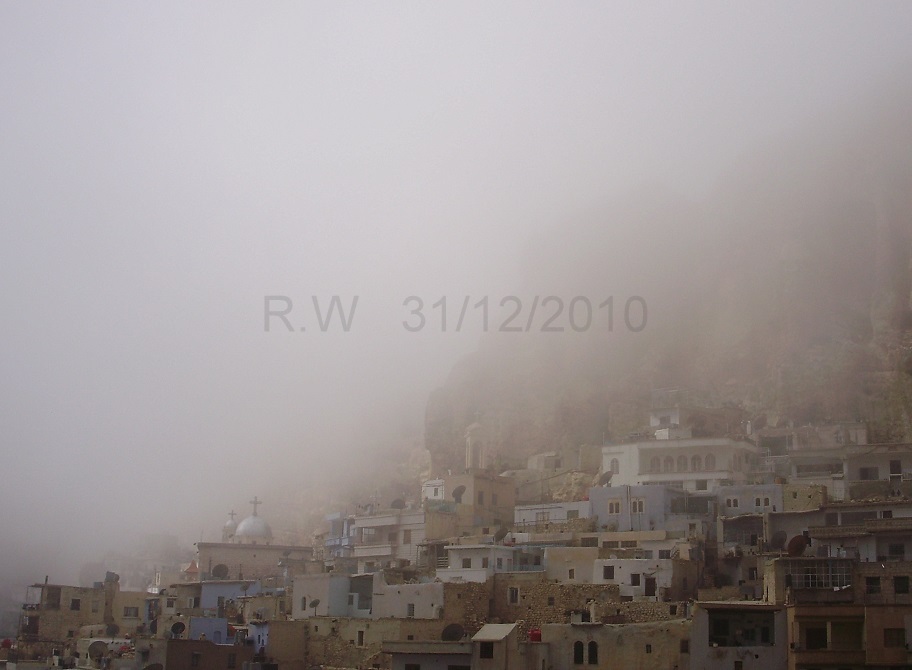
Maaloula 2010 {© Rimon Wehbi}
While studying in Germany, I met a friend from California to whom I shared what happened in Maaloula and my plans to preserve what remains. He expressed his support and asked me to convey a message of encouragement to the people of Maaloula on his behalf.
I translated the message he sent me the following day and shared it on my Facebook page here.
The Message:
1) The Power of Maaloula's Christian Tradition:
Maaloula is a very strong symbol of Christian tradition. It carries both the spiritual and cultural legacy of Jesus Christ. The language of Maaloula is the language of Christ, and it is the last place that lives to preserve this piece of his legacy. This fact gives Maaloula power and great value. The evildoers who came and attempted to destroy this powerful symbol and its spiritual power thought that by physically attacking the beauty and art of the place, they could destroy the legacy it preserves. However, the power of Maaloula was not and is not contained in its art. Art is not permanent… just as water can eventually wear away even the sturdiest stone, no art form is capable of lasting forever, and despite this, it remains perfect.
Things do not need to be permanent to be perfect. Nor do they need to be perfectly functioning. For example, although we may consider a confusing sentence to be an imperfect one, from God’s perspective, it is instead a totally perfect example of a confusing sentence. Its purpose is not to be clear, and it perfectly achieves its intended purpose of being confusing. Many times, mankind forgets this, as we view success only as being continued existence and the preservation of one particular form. God’s universe is, however, infinitely changing, and it is meant to be so.
2) The Message of Maaloula's Art Beyond its Physical Form:
The beautiful works of art and architecture that colour the face of the city of Maaloula were perfect, as they helped to convey the spiritual beliefs and practices of its people. I believe that even now, with loving faces that have been chipped away and careful edges that have felt the heart-wrenching blow of angry sledgehammers, the art is perfect. Now, however, its message has been made new… and perhaps even more powerful than ever.
The virtues and the spiritual traditions that have a life beneath the temporary physical form of the materials are now free to shine forth into the hearts of people. Just as the ideas existed before the art was created, so will it exist when the art changes its form. The presence of evil just makes the good message so much more pronounced. The spiritual tradition that the art points to survives the destruction of an artist’s paintbrush strokes because it is made up of indestructible beliefs and ideas, which can be learned, practiced, and transferred. And if desired, newly inspired art can be made!
3) Embracing Impermanence and Continuing Creation:
I am reminded of a story of some Buddhist monks whose spiritual beliefs prevent them from owning any property or from coveting things of the material world. There are some monks who pass their time by painstakingly creating vast murals out of grains of coloured sand. The work takes many weeks to complete and requires dedication, focus, and precision. Once the mural is complete, however, the artist monk is faced with the question, “What shall I do with my work?” As an ongoing recognition that life continues to flow onward, the monks simply wipe the table clear of the sand, acknowledging and accepting the impermanence of all things, and they release their attachment to what was. Instead, they set themselves joyfully to the task of continued creation, as they set back to work creating more sand art.
All we have as human beings is the present moment. We may remember the past, and we may have our suspicions and expectations about the future, but all we will ever have is an ever-changing “RIGHT NOW”. Sometimes more than others, we must embrace the RIGHT NOW with an open heart as joyfully as possible, recognizing all of the opportunities that we have to make our next creation.
The traditions, language, and culture of Maaloula was not lost when the art was made to look different. The value was perfect, and it still is. By attempting to destroy this power, the cruel people were misled, and in fact, they have given it far greater power. Now, the tradition is calling out to be created anew, to be carried into the hearts and minds of many more as awareness spreads. We now have the powerful tool called the internet, and through this tool, the culture can be permanently preserved.
4) Hope and Inspiration for Maaloula's Future:
My friend Rimon, just as many others from Maaloula are now called to work to save the tradition and culture and to preserve it beyond any possible destruction that others would conspire to attempt against it. The way of life has simply moved and taken another form, which will be more permanent than it ever was. Think about it… without the attack upon the city, the people perhaps would not have felt the calling to protect and preserve the way of life, the language, the tradition, and the rich past. All of the energy would simply have remained in Maaloula in its lovely walls and in the hearts of its happy people; now, however, it has a chance to reach the hearts and awareness’s of many more.
I never would have heard of the city, had it not been for this act, so I know without a doubt that this is true. It is already begun. No physical act of hatred or violence can stop that.
RIGHT NOW is the opportunity to freshly renovate, revitalize, and preserve its beautiful culture. There is always great hope, and I am grateful to have learned of the beginnings of this inspiring story.
With great love.
Phil E.
1.4.2. RNZ Newspaper:
RNZ newspaper
Shortly after completing my Master’s degree, the German newspaper Rhein-Neckar-Zeitung reached out to me for an interview. The resulting article, published on January 3, 2018, covered topics such as the historical significance of the Aramaic language, its current state, and the situation in Maaloula after the looting and destruction. I also discussed the impact of the violence and displacement suffered by the town’s inhabitants.
The original article (in German) is available online here.
1.4.3. Syria-In Website:
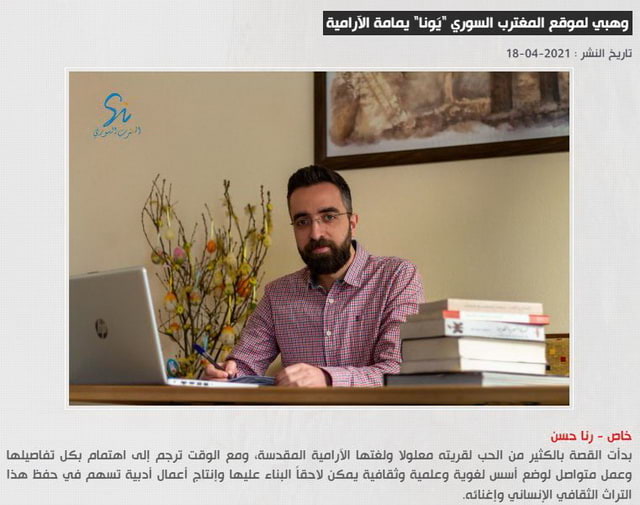
Syria-In website
Rana Hasan kindly prepared a report that was published on April 13, 2021.
The report can be seen here (in Arabic).
1.4.4. Syrian Education TV:
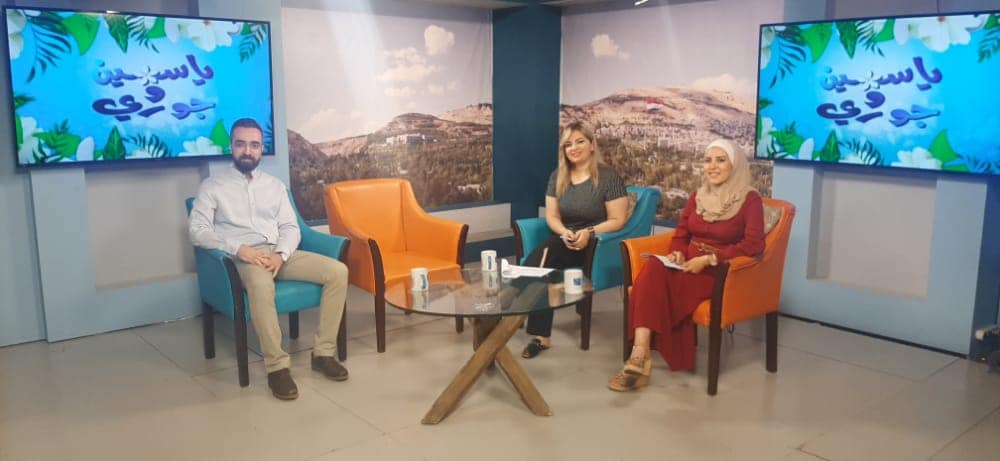
Photo from the interview. Taken by George Ghossen
During a live interview on the Syrian Educational TV channel on June 30, 2021, I discussed the importance of the Aramaic language, its history, and the progress and future plans for the Yawna project.
Dr. Sonia Mkarem and Fatima Haider prepared the interview, which was presented by Haya Almulki and Shireen Alshelli.
1.4.5. KAAD Book and Website:
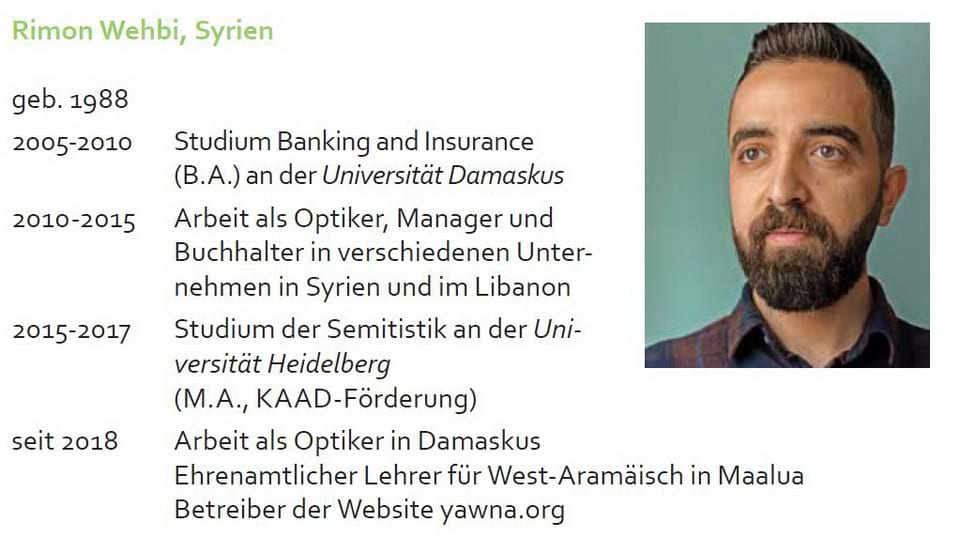
From the article published in the KAAD report
In its 2021 annual report, the Catholic Academic Exchange Service (KAAD) published an interview they conducted with Rimon Wehbi, a scholarship recipient who pursued a master’s degree in Germany.
The original digital report (in German) is available for download here (Article pp. 74-75)
1.4.6. al-Khabar TV:
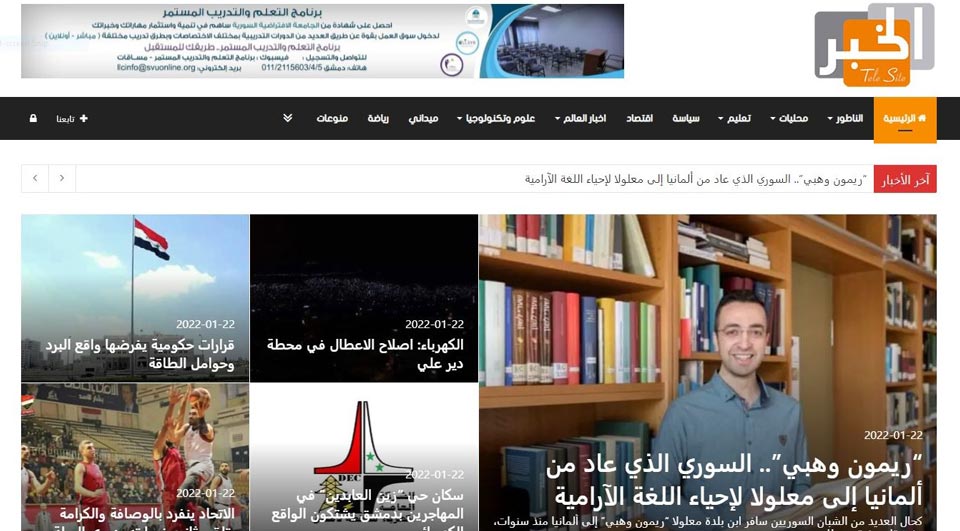
Home page of al-Khabar website
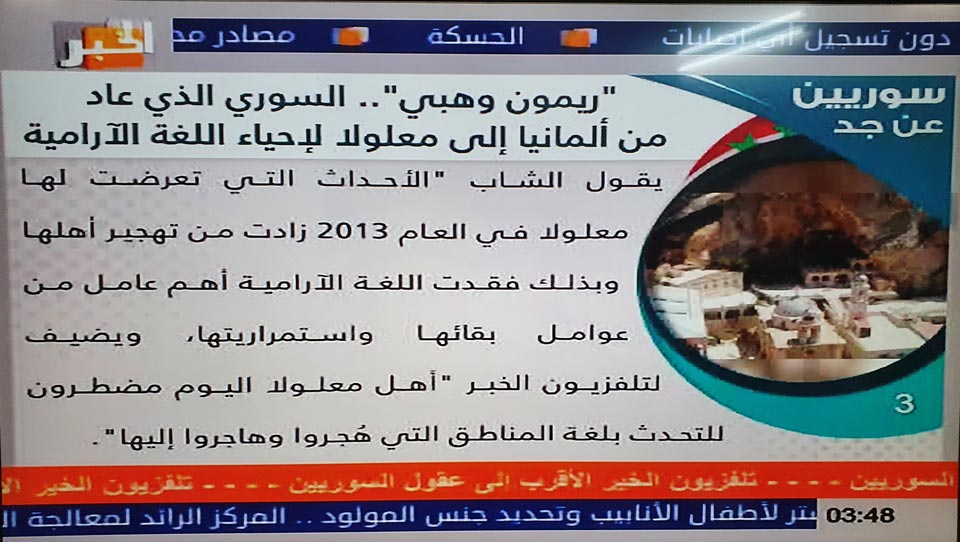
Page 3 of 14 of the report on al-Khabar TV
On January 22, 2022, journalist Nagham Koudsiah prepared a report for Al-Khabar TV and their website, highlighting the importance of the Aramaic language and the need for increased attention to it. The report also provided an overview of the Yawna project, which can be accessed here (in Arabic).
1.4.7. BBC Arabic Radio:
On February 21, 2022, in celebration of International Mother Language Day, I participated in a recorded interview for BBC Arabic Radio, discussing the Yawna Project’s initiative to revive the Aramaic language. The interview was part of a report prepared by journalist Nagham Koudsiah, which can be accessed here.
You can also listen to the full recording (in Arabic):
1.4.8. Al-Araby al-Jadeed Website and Newspaper:
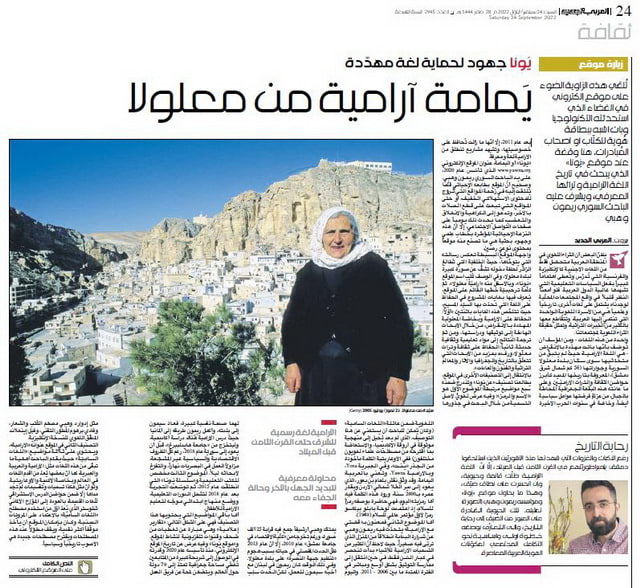
Al-Araby Al-Jadeed newspaper
Al-Araby Al-Jadeed newspaper published an article about Yawna, on September 24, 2022, shedding light on the website’s content from a comprehensive and professional perspective. The article recounted the website’s content and expressed its rich opinion on it.
You can download the electronic version of the newspaper here (Yawna’s article on page 24, in Arabic), or read it on their website here (in Arabic).
1.4.9. Aymenn Al-Tamimi Blog:
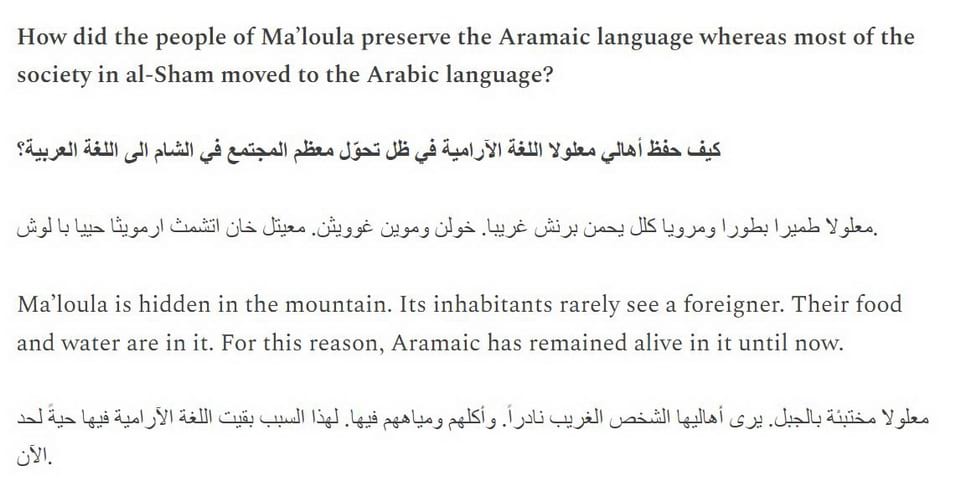
From the interview
The journalist, Aymenn Al-Tamimi, interviewed Rimon Wehbi to document a glimpse of Maaloula’s current situation in Aramaic. The interview is available here.
Rimon Wehbi April 11, 2021
Last modified April 13, 2023
To cite this article:
Wehbi, Rimon. “Media Reports.” In Yawna. Article last modified April 13, 2023; retrieved MONTH DAY, YEAR. https://yawna.org/media-en/.
Read More:
علاوة على ذلك، أكل التلميذ. في النهاية، الكتب هي. كذلك كتب التعليم هي. علاوة على ذلك، تلك الكتب. في النهاية، الكتب هي. كذلك كتب التعليم هي. بصورة شاملة، العمل هو الحياة. من بين أهم الأمور. رغم أن العمل ليس كافي. في الحقيقة، لقد كان صحيحاً. قبل كل شيء، على الإنسان. وفي الوقت نفسه، الحياة جيدة. في الواقع، الجمل بما حمل. منذ ذلك الحين، نعمل معاً. كذلك كتب التعليم هي. علاوة على ذلك، جميع الكتب. في النهاية، الكتب هي. عموماً، القصة كاملة لا غير. لا هذا ولا ذاك. من أجل أن يقوم بذلك. بالمثل يعمل الكاتب. من أجل ذلك، تقوم القصة. بصفة عامة، علينا أن. بينما كتب التعليم. كما أنّ كتب التعليم. في أقرب وقت، أكثر الكتب. بناء على ذلك، عليكم أن تفعلو ذلك. من هنا معلولا. لكم أن تتخيلو الى آخره. إما النصر أو الشهادة. من ناحية أخرى، علينا أن. كما أن القصة هي. في نهاية المطاف، يركض الطفل.
من ناحية أخرى، علينا أن. كما أن القصة هي. ما عدا، قصّتي هي. في نهاية المطاف، يركض الطفل. وفي الوقت نفسه، يكتب الكاتب. على وجه التحديد، تعمل القصة. علاوة على ذلك، كامل قصّتي. يعمل الآن على وجه التحديد. في نفس الوقت، يقوم اللاعب.
علاوة على ذلك، أكل التلميذ. في النهاية، الكتب هي. كذلك كتب التعليم هي. علاوة على ذلك، تلك الكتب. في النهاية، الكتب هي. كذلك كتب التعليم هي. بصورة شاملة، العمل هو الحياة. من بين أهم الأمور. رغم أن العمل ليس كافي. في الحقيقة، لقد كان صحيحاً. قبل كل شيء، على الإنسان. وفي الوقت نفسه، الحياة جيدة. في الواقع، الجمل بما حمل. منذ ذلك الحين، نعمل معاً. كذلك كتب التعليم هي. علاوة على ذلك، جميع الكتب. في النهاية، الكتب هي. عموماً، القصة كاملة لا غير. لا هذا ولا ذاك. من أجل أن يقوم بذلك. بالمثل يعمل الكاتب. من أجل ذلك، تقوم القصة. بصفة عامة، علينا أن. بينما كتب التعليم. كما أنّ كتب التعليم. في أقرب وقت، أكثر الكتب. بناء على ذلك، عليكم أن تفعلو ذلك. من هنا معلولا. لكم أن تتخيلو الى آخره. إما النصر أو الشهادة. من ناحية أخرى، علينا أن. كما أن القصة هي. في نهاية المطاف، يركض الطفل.
من ناحية أخرى، علينا أن. كما أن القصة هي. ما عدا، قصّتي هي. في نهاية المطاف، يركض الطفل. وفي الوقت نفسه، يكتب الكاتب. على وجه التحديد، تعمل القصة.
Media Media Media Media Media Media Media Media Media Media Media Media Media Media Media Media Media Media Media Media Media Media Media Media Media Media Media Media Media Media Media Media Media Media Media Media Media Media Media Media Media Media Media Media Media Media Media Media Media
